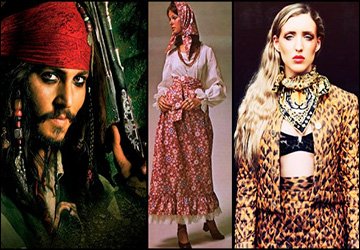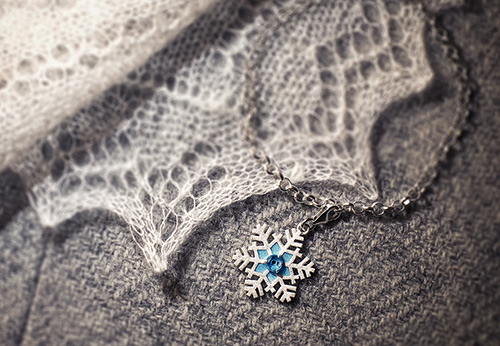Fashion history
The history of the headscarf and shawl
And the impossible is possible
The road is long and easy
When it flashes in the road dust
Instant look from under the handkerchief. (A. Blok)
A headscarf is a headdress that never ceases to amaze. An ordinary canvas of fabric allows us to create different images using original ways of tying a scarf.
The first mention of a headscarf as a headdress dates back to times of the Egyptian pharaohs - in 2000, only BC.

Both in Egypt and in Assyria, the headscarf demonstrated the social position of the owner. The headdress of the pharaohs was called him? S. It was a scarf, which was a sign of power and emphasized the godliness of the ruler. The scarf was twisted in a knot at the back, on the sides it went down to the shoulders in long folds. Most often, the scarf was in a bright blue-gold strip. In front of the head was attached an urey - the symbol of the cobra goddess Uajit, the patroness of Lower Egypt.

The patroness of Upper Egypt was the vulture goddess. Together, these two images symbolized the unity of Egypt. In ancient times, signs and symbols were of great importance, emphasizing not only the status of the owner, but also special advantages. The Sphinx at Giza with the body of a lion and the face of a man (with the facial features of Pharaoh Khafren) is also covered with nemes.


They covered their heads with a scarf since ancient times and in Europe. Among many peoples, covering the head with a headscarf was the rule of decency. Most often, a headscarf was required for a woman, an unmarried girl was allowed to be bareheaded. In addition, the headscarf on the woman's head also emphasized her status and at the same time protected from bad weather. In Germany, women began to wear long veils, which fluttered freely on their shoulders, and were fastened with a brooch under the chin.

In the 800s, Emperor Charlemagne managed to find a common language with the Baghdad caliph, establishing close diplomatic relations, which resulted in trade between the countries. Among the goods imported from the East were silk bright fabrics and transparent weightless veils. Ladies began to wear them, covering their heads, in the manner of capes, as they now cover their heads with a bride's veil.


The veil entered the woman's wardrobe for a long time. In the 11th century in Europe, they began to wear gebend as a headdress - two strips of fabric, one of which was tied around the head, and the other framed the face. The first strip was decorated with ruffles or embroidery; sometimes a veil was tied to the gebend.
In the XIII-XV centuries, in addition to the veil, a very original headdress appeared - a high cone (annen) with a veil or even a train. By the way, the more noble the lady, the higher the cone, which the princesses have, reaching up to a meter.



In the 16th century, the head, or rather the hair, began to be decorated with a net, which kept the hairstyle under a cap or beret, and hats trimmed with fur were also worn.
In the 17th - 18th centuries, headscarves had to give way to new headdresses - hoods, and then hats.
By the beginning of the 19th century, shawls became fashionable. It is believed that it arose after Napoleon's Egyptian campaign, returning from which he brought Kashmir shawls to his Josephine. French aristocrats were not slow to repeat the experience of the first beauty of France, and after them all the ladies of Europe.


Shawls fell to taste not only as a beautiful accessory to Empire-style outfits, but also as protection from the cold. The shawls were wide and narrow, long and square. In those days, the art of draping shawls was appreciated. They were so popular that the pas de chal dance even appeared. Shawls began to be produced in England, Scotland, Belgium, France. The ladies were delighted with the famous Lyons silk shawls and bright Russians. By the way, the history of the headscarf in Russia is a completely separate topic, which we will remember more than once again.
After all, "the wilder the village, the brighter the scarf" - this is what the Russian proverb says.A Russian woman wrapped in a patterned dress is the image of our Motherland - Russia. Russian beauties greeted winter holidays with sledding in colorful shawls or in Orenburg shawls, the very ones that easily passed through the wedding ring, and warmed them in the most bitter frosts. All this beauty was created by the hands of Russian craftswomen for a long time, and they started talking about shawls in Europe, as already mentioned, from the beginning of the 19th century.

Since then, the shawl has forever entered a woman's wardrobe. It remained a popular accessory until the 1920s, then it did not disappear, it just made room to give way to hats. In the second half of the twentieth century, the shawl again took its place in the accessories of women's wardrobe. At the end of the 60s, scarves in Indian folklore style became fashionable.
Silk shawls have become extremely popular. They were worn by everyone, including the stars - Brigitte Bardot, Grace Kelly, Audrey Hepburn, Jacqueline Kennedy and many others. It was the stars that brought glory to some of them, which have become the trademarks of famous brands. For example, Herm's "square" shawl became famous thanks to the Princess of Monaco Grace Kelly.
Then the scarves and shawls again moved a little to the side to give way to berets, hoods, knitted hats, sports caps, and elegant men's hats.


Now again, scarves and shawls are back to not only decorate a woman's head, but also to create original clothing models. They are used in different interpretations. Today it is again a stylish and fashionable accessory. A wide shawl can be thrown diagonally over the body and pulled off with a strap at the waist. You will be like a Greek goddess. The shawl can be tied around the waist or on the hips, the main thing is to choose the right shawl color for your outfit, preferably in a contrasting tone.
the famous poster, where the riveter Rosie, representing women workers, showed off her muscles to everyone, looks great in a headscarf tied around her head with a bow on top of her head. This option is very suitable in cases where the hairstyle is not all right or you are just too lazy to do it.

Tell friends:
Comments and Reviews
Add a comment
Rating news
Shades of clothing that make women look younger
What shades of hair make women younger: rules and photos
Funny wedding dresses - photos and ideas
12 most expensive down jackets for the winter
How to look 25 at 40: tips from supermodels
Beautiful schoolgirls
Anti-aging haircuts and hairstyles for women
Fashionable skirts for autumn and winter
Fashionable women's trousers for the cold season
Fashionable and stylish sandals for summer 2020
Spring-summer 2021
 Fashionable dresses and tops with thin spaghetti straps
Fashionable dresses and tops with thin spaghetti straps
 Bandana tops: how to wear stylishly and beautifully
Bandana tops: how to wear stylishly and beautifully
 How to put together the perfect men's wardrobe for the summer
How to put together the perfect men's wardrobe for the summer
 Fashionable shorts for spring-summer 2021
Fashionable shorts for spring-summer 2021
 Fashionable skirts for spring-summer 2021: a guide to online shopping
Fashionable skirts for spring-summer 2021: a guide to online shopping
 The most fashionable dresses spring-summer 2021: styles and colors
The most fashionable dresses spring-summer 2021: styles and colors
 Fashionable total look 2021: ideas of images and trends
Fashionable total look 2021: ideas of images and trends





